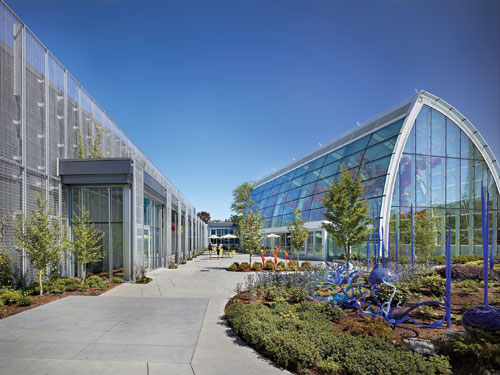Windows on Sustainability
| Definition of Terms |
U-factor and U-value are interchangeable terms referring to a measure of the heat gain or loss through glass due to the difference between indoor and outdoor air temperatures. U-factor or U-value is also referred to as the overall coefficient of heat transfer. A lower U-value indicates better insulating R-value equals a measure of the resistance of the glazing to heat flow. It is determined by dividing the U-value into 1, (R-value = 1/U-value). A higher R-value indicates better insulating properties of the glazing. R-value is not typically used as a measurement for glazing products. Both U-value and R-value are a measure of resistance to heat flow and are referenced here to help understand U-factor. The solar heat gain coefficient (SHGC) is the percent of solar energy incident on the glass that is transferred indoors both directly and indirectly through the glass. The direct gain portion is the solar energy transmittance, while the indirect is the fraction of solar energy incident on the glass that is absorbed and re-radiated or transmitted through convection indoors. For example, 1/8-inch (3.1 mm) uncoated clear glass has an SHGC of approximately 0.86, of which 0.84 is direct gain (solar transmittance) and 0.02 is indirect The shading coefficient (SC ) is a measure of the heat gain through glass from solar radiation. Specifically, the shading coefficient is the ratio between the solar heat gain for a particular type of glass and that of double-strength clear glass, that is 1/8-inch glass. A lower shading coefficient indicates lower solar heat gain. For reference, 1/8-inch (3.1 mm) clear glass has a value of 1.00 (SC is an older term being replaced by the SHGC). In either case, a lower number indicates improved solar control over the 1/8-inch clear glass baseline. With a long air-conditioning season, it is most important to reduce solar gain and therefore reduce air-conditioning loads. |
High-Performance Low-E Glass
First introduced in the 1980s, low-E commercial coatings refer to glass with low-emissivity coatings, microscopically thin metal layers that are deposited on a window surface to help keep heat on the same side of the glass from which it originated. Low-E glass reduces heat gain or loss by reflecting long-wave infrared energy, or heat, and therefore, decreases the U-value and solar heat gain, and in doing so, improves the energy efficiency of the glazing. Because of its relative neutrality in appearance and energy efficiency, low-E glass is widely used in residential and commercial buildings and is expected to continue to increase in usage in the coming years. If a higher solar gain low-E coating is specified, the higher heat load from solar transmission can burden the cooling system, causing energy costs to rise more than necessary as the air-conditioning system overworks to maintain a comfortable temperature throughout all sections of the building. In addition to controlling the solar heat gain inside a building, the correct glass can affect the size and efficiency of the HVAC equipment as well as daylighting systems. Minimizing solar heat gain through low-E coatings can actually significantly reduce the size of an HVAC unit.
The first low-E glasses had SHGCs of between 0.4 and 0.7, the SHGC being the fraction of the heat from the sun that enters through a window, expressed as a number between 0 and 1, with the lower a window's SHGC, the less solar heat it transmits. Over the years the energy codes have gotten stricter. Both ASHRAE 90.1-2010 and the 2012 International Energy Conservation Code require a maximum 0.25 SHGC in zones 1-3 (resourcecenter.pnl.gov/cocoon/morf/
ResourceCenter/graphic/973) for any window-to-wall ratio up to 40 percent. Glass manufacturers keep improving on those numbers through new higher-performing low-E technologies that balance energy performance of glass and the aesthetics.
A recent study by engineering company Enermodal Engineering Inc. compared the energy savings of a new high-performance low-E coating to a standard commercial low-E coating widely used in recent years. Simulating a 175,000-square-foot 10-story office building, the study found the low-E glass to have the potential to save $2.50 per square foot of glass by downsizing the chilled water and air distribution systems. In terms of operational cost savings, annual energy costs are lowered by as much as $1.60 per square foot of glass in a building with glare and daylighting controls. In total, the higher-performance coating offered a 30 percent improvement in energy performance for a very small increase in glass cost. The return on investment would be realized in one to two years. The simulated coating offered a neutral appearance, glare control and a lower solar heat gain that enabled the downsizing of the building's HVAC system upfront, in addition to ongoing energy savings.
In general there are two ways to apply coatings to glass, through either a pyrolytic or sputter process.
 |
Advanced architectural glass helps architects create striking building designs while significantly reducing energy costs. Chihuly Garden and Glass House, Owen Richards Architects. Photo by Ben Benschneider, Artwork © Copyright, Chihuly Studio, 2012, all rights reserved |









